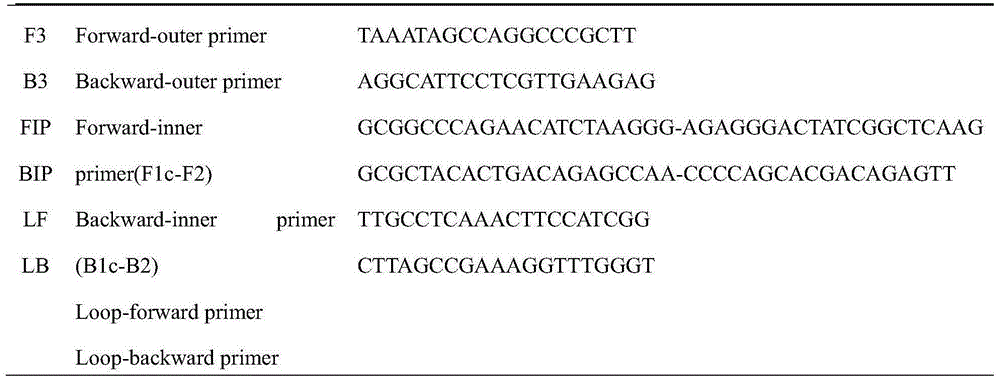Method for detecting characteristic fungus Amorphotheca resinae in jet fuel
A technology of jet fuel and fungi, applied in the field of microbial detection, can solve the problems of expensive, complicated operation, long time-consuming, etc., and achieve the effect of short detection time, high sensitivity, and improved early warning ability
- Summary
- Abstract
- Description
- Claims
- Application Information
AI Technical Summary
Problems solved by technology
Method used
Image
Examples
Embodiment 1
[0017] Embodiment 1: primer design and synthesis
[0018] The applicant has found in long-term research that, in addition to A.resinae, fungi in jet fuel also have Trichoderma viride, Penicillium funiculosum, Aspergillus niger, and short-stemmed shoots. Aureobasidium pullulans, therefore, after comparing the A.resinae18S gene sequence with the above four bacteria, the specific sequence of A.resinae was screened out to design a LAMP group, and after sensitivity and specificity screening, the A.resinae including exogenous Primers (F3, B3), internal primers (FIP, BIP), and loop primers (LF, LB) included 6 LAMP primers (Table 1). Among them, FIP is labeled with biotin, and FITC is added to LF. Primers were synthesized by Dalian Bao Biological Company.
[0019] Table 1: A. resinae LAMP primer sequences
[0020]
[0021]
Embodiment 2
[0022] Example 2: Detection of A. resinae
[0023] Amplification conditions were optimized using the genomic DNA of A. resinae as a template. The LAMP method DNA reaction kit was purchased from Rongyan Biotechnology Co., Ltd. The concentration of each primer is: FIP-bio and BIP each 1.6 μmol / L, F3 and B3 each 0.2 μmol / L, LF-fitc and LB each 0.8 μmol / L; buffer composition and concentration: Tris-HCl (pH 8.8) 20mmol / L, KCl 10mmol / L, MgSO 4 8mmol / L, (NH 4 ) 2 SO 4 10mmol / L, Tween200.1%, Betaine 0.8mol / L, dNTPs 1.4mmol / L; 8U Bst DNA polymerase; A. resinae genomic DNA was extracted with a kit. LFD adopts German Milenia GenLine HybriDetect kit. The LAMP-LFD reaction system is shown in Table 2.
[0024] Table 2: LAMP-LFD reaction system
[0025]
[0026] The volume was adjusted to 25 μL with double distilled water, and no DNA template was added in the negative control experiment. The amplification was carried out at the optimized reaction temperature and time, and the rea...
Embodiment 3
[0037] Example 3: Detection Application of Jet Fuel Samples
[0038] Take samples from the bottom of 9 storage tanks, filter 100mL of each oil sample through a 0.45μm filter membrane, collect the filter membrane and mark several samples respectively Jet fuel 1, Jet fuel 2, Jet fuel 3, Jet fuel 4, Jet fuel Fuel 5, Jet fuel 6, Jet fuel 7, Jet fuel 8, Jet fuel 9, the collected filter membrane was eluted repeatedly with 500μL 10% chelex-100, the eluate was collected in a 1.5mL EP tube, and the chelex-100 method was used to Extract the DNA template. And use the designed LAMP-LFD method to detect whether there is A.resinae; the results are shown in Table 3.
[0039] Table 3: Detection results of jet fuel samples by LAMP-LFD and culture method
[0040]
[0041] Note: +. Positive; —. Negative
[0042] The above results show that the results obtained by the primer set and detection method of the present invention are consistent with the results of bacterial culture, which proves ...
PUM
 Login to View More
Login to View More Abstract
Description
Claims
Application Information
 Login to View More
Login to View More - R&D
- Intellectual Property
- Life Sciences
- Materials
- Tech Scout
- Unparalleled Data Quality
- Higher Quality Content
- 60% Fewer Hallucinations
Browse by: Latest US Patents, China's latest patents, Technical Efficacy Thesaurus, Application Domain, Technology Topic, Popular Technical Reports.
© 2025 PatSnap. All rights reserved.Legal|Privacy policy|Modern Slavery Act Transparency Statement|Sitemap|About US| Contact US: help@patsnap.com



